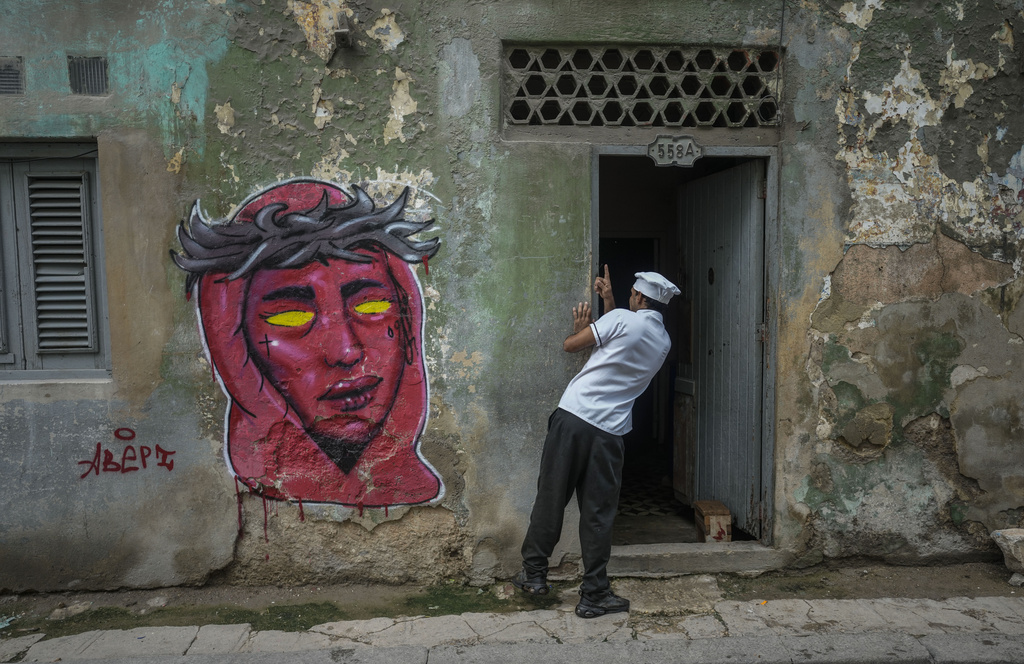Cuban Energy Crisis Worsens After Major Power Plant Breakdown \ Newslooks \ Washington DC \ Mary Sidiqi \ Evening Edition \ Millions of Cubans faced a two-day blackout after a failure at the Antonio Guiteras thermoelectric plant caused a nationwide outage. Despite partial restoration of electricity, large portions of the country remain without power. The breakdown is one of Cuba’s worst in recent years, highlighting the country’s deepening energy issues, exacerbated by increasing demand, aging infrastructure, and U.S. sanctions.

Cuban Power Grid Failure: Quick Looks
- Nationwide Blackout in Cuba: A breakdown at the Antonio Guiteras power plant led to widespread outages across the island.
- Increased Demand Strains Outdated System: Rising demand, especially from air conditioners, overwhelmed Cuba’s energy grid.
- Aging Infrastructure: Cuba’s power grid, weakened by lack of maintenance and U.S. sanctions, continues to face major failures.
- Hurricane Threat Looms: As power restoration continued, Cuba issued hurricane watches for the eastern provinces due to Hurricane Oscar.
- Protests Likely: Widespread blackouts have historically led to social unrest, raising concerns about potential protests.
- Plans for Renewable Energy: Cuba is pushing to modernize its grid by investing in solar energy projects as a long-term solution.
Deep Look:
Millions of Cubans were left in the dark for two days following a failure at the Antonio Guiteras thermoelectric plant, one of the island’s most critical power facilities. The widespread blackout, which began on Thursday evening and continued into Saturday, affected nearly the entire island and underscored the worsening energy crisis in Cuba. For many, this outage is reminiscent of previous blackouts caused by powerful hurricanes, but this time, the failure was purely a result of the country’s aging and increasingly unreliable energy grid.
The blackout started on Thursday evening, leaving about half of Cuba without power. By Friday morning, the entire island had lost electricity. The source of the problem was traced back to the Antonio Guiteras plant, located in Matanzas Province, east of Havana. This plant, essential to Cuba’s national energy supply, has long suffered from maintenance issues due to a lack of resources and access to parts. The situation has become more acute in recent years, as U.S. sanctions continue to limit the Cuban government’s ability to acquire the hard currency needed to maintain critical infrastructure.
The extent of this blackout shocked many Cubans, who are accustomed to periodic power outages due to the country’s economic difficulties. However, the scale of this incident was unprecedented in modern times, barring natural disasters like hurricanes. The government scrambled to restore power to affected areas, but by Saturday, significant portions of the island remained without electricity. As officials continued efforts to fix the power grid, a new threat loomed: Tropical Storm Oscar had developed into a hurricane, prompting the issuance of hurricane watches for the far eastern provinces of Guantanamo, Holguin, and Las Tunas. The storm, the 10th hurricane of the 2024 Atlantic season, raised further concerns about Cuba’s ability to handle the double strain of a natural disaster and an energy crisis.
The immediate cause of the blackout was the collapse of the aging Antonio Guiteras plant, which could not handle the surging demand for electricity. This year alone, about 100,000 new air conditioners were installed in homes and businesses across Cuba, significantly increasing the strain on the already fragile grid. The proliferation of small- and medium-sized businesses, made possible by economic reforms in 2021, further boosted electricity demand. At the same time, Cuba’s thermoelectric plants, including Antonio Guiteras, have not been properly maintained due to financial constraints, leading to frequent breakdowns.
The government pointed to the combination of increased demand and outdated infrastructure as the main reasons for the blackout. However, underlying these issues is Cuba’s reliance on crude oil to fuel its thermoelectric plants. While the country produces about half of the oil it needs, the remainder must be imported at high costs due to international sanctions, particularly those imposed by the United States. These sanctions have made it increasingly difficult for Cuba to purchase fuel on the global market, adding to the nation’s energy woes. In the past, Cuba has relied on Venezuela and Russia for cheaper oil, but those relationships have not been enough to prevent repeated power failures.
Cuba’s energy grid has long been unstable, with regular blackouts affecting large parts of the country. In 2024 alone, some regions have experienced outages lasting up to eight hours a day. During the current blackout, officials reported that 1.64 gigawatts of power—roughly half of the island’s total demand at peak hours—went offline, leading to significant disruptions. In response, the Cuban government implemented a series of emergency measures, including suspending classes, reducing operations in state-owned enterprises, and halting non-essential services to lower electricity consumption.
This is not the first time Cuba has faced such an energy crisis. In 2022, Hurricane Ian, a powerful Category 3 storm, caused widespread damage to the island’s power infrastructure, leading to days-long outages. While the government was able to restore power within days, the incident exposed the vulnerabilities of Cuba’s energy system. Since then, little progress has been made in stabilizing the grid, and experts warn that further blackouts are likely unless significant investments are made in upgrading the country’s infrastructure.
The political ramifications of the blackout are yet to be seen, but the possibility of unrest looms large. In July 2021, widespread blackouts and economic hardships sparked the largest protests Cuba had seen in decades, with thousands of people taking to the streets to express their frustrations. The government’s harsh response to these protests drew international condemnation and highlighted the fragility of Cuba’s political landscape. Smaller demonstrations followed in October 2022 and March 2024, as citizens continued to voice their frustrations over frequent power outages. The current blackout, if prolonged, could reignite these tensions.
Looking ahead, the Cuban government is focusing on both short-term and long-term solutions to stabilize the country’s energy supply. In the short term, the state-owned power company UNE is using distributed generation methods to restore power to parts of the island. Additionally, a gas-fired thermoelectric plant is being brought online to supplement electricity generation. However, these measures may not be enough to prevent further blackouts, given the fragility of the grid and ongoing fuel shortages.
In the long term, Cuba is working on a series of projects to modernize its energy infrastructure. One of the key initiatives is the development of renewable energy sources, particularly solar power. The government has been constructing 31 solar energy centers across the island, with plans to complete the project by the end of 2025. The shift to solar energy is seen as a critical step in reducing Cuba’s dependence on imported crude oil and stabilizing its power grid. In addition to solar power, Cuba is exploring other forms of renewable energy, including wind and biomass, as part of its broader strategy to diversify its energy mix.
President Miguel Díaz-Canel has assured the public that the government is treating the current blackout with the utmost urgency. In a statement posted on X (formerly Twitter), he acknowledged the severity of the situation and pledged that authorities would work around the clock to restore power as quickly as possible. “We are devoting absolute priority to addressing and solving this highly sensitive energy contingency,” Díaz-Canel wrote. “There will be no rest until its restoration.”
As Cuba faces the twin challenges of restoring power and preparing for a potential hurricane, the country’s energy crisis is unlikely to be resolved soon. While the government’s efforts to modernize the grid and transition to renewable energy are a step in the right direction, the ongoing impacts of U.S. sanctions, outdated infrastructure, and financial limitations mean that Cuba’s energy sector will remain vulnerable for the foreseeable future. Nonetheless, the Cuban government remains committed to finding a solution, with hopes that alternative energy sources will play a significant role in stabilizing the nation’s power grid in the years to come.
Cuban Energy Cuban Energy







